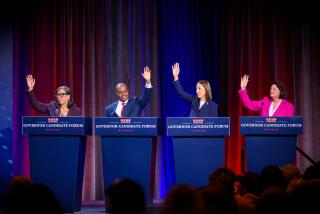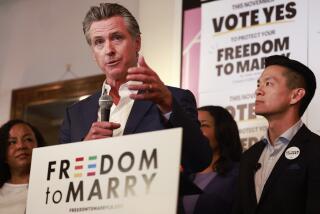How single-payer healthcare became the biggest policy flashpoint in California’s race for governor
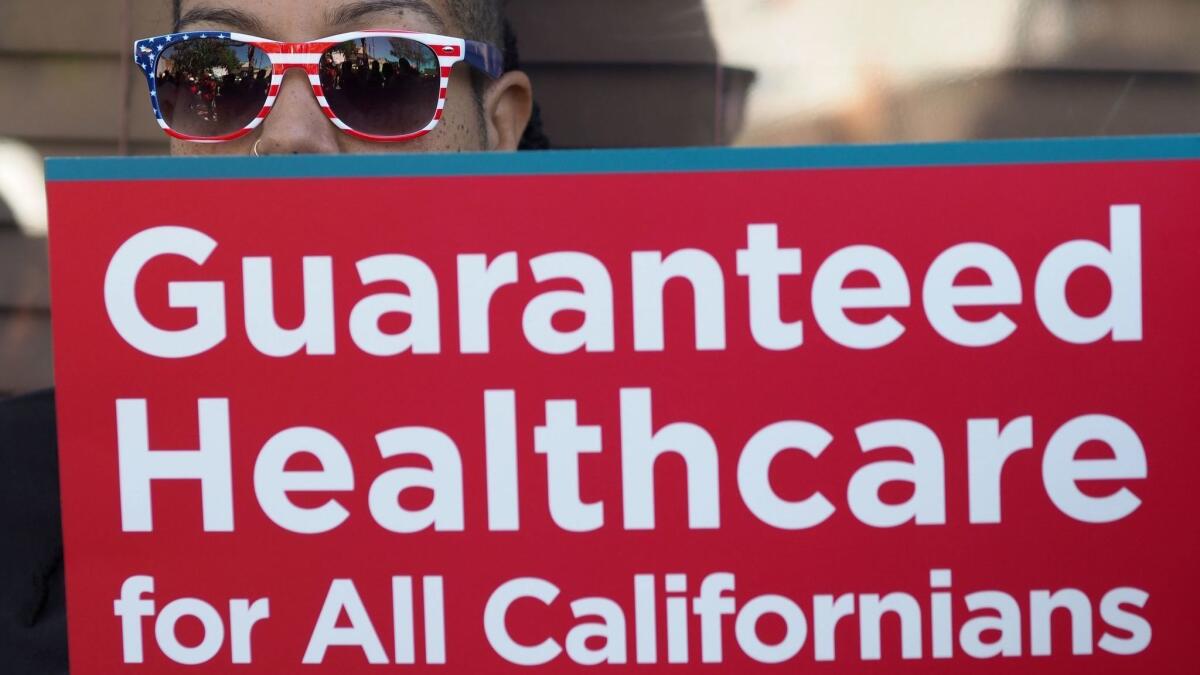
Reporting from Sacramento — When Gavin Newsom campaigns on his support for a California single-payer healthcare system, he’s talking about more than the virtues of universal care. He’s trying to sell himself as a bold visionary.
When Antonio Villariagosa warns of the financial calamity that awaits if the state adopts single payer, he’s trying to send a different message — that he’s a fiscally responsible realist who won’t make promises he can’t keep.
The debate over single payer in California’s race for governor reaches beyond how best to cure the inadequacies of healthcare in the state. It’s a political marker for the top Democratic candidates trying to woo different factions of their divided party, and has emerged as the biggest policy flashpoint in the campaign.
“Single-payer healthcare has become a clear litmus test. If you support it, you’re a pure progressive. If you’re opposed to it, you’re a pragmatist,” UC San Diego political scientist Thad Kousser said. “It’s more of a declaration than a policy promise because this is never going to happen, certainly during the Trump presidency.”
But Newsom has promised to pursue a state-supported single-payer healthcare system if he’s elected in November. And fellow Democratic candidate Delaine Eastin, a former state superintendent of public instruction, also declared herself all-in on the concept. Both say California should lead the way, but have been criticized by their rivals for failing to provide a concrete plan to fund such a program or overcome the many obstacles it would face.
Depending on who becomes the next governor, every Californian’s well being and bank account could potentially undergo a revolutionary change. With the June 5 primary just two months away, Newsom remains the clear front-runner.
Coverage of California politics »
“My opponents call it ‘snake oil,’” Newsom said at the California Democratic Party convention in February, a reference to Villaraigosa’s oft-used criticism of the lieutenant governor’s support for the plan. “I call it single payer. It’s about access. It’s about affordability. And it’s about time. If these can’t-do Democrats were in charge, we wouldn’t have had Social Security or Medicare.”
Villaraigosa dismisses Newsom’s campaign promise as a hollow attempt to entice the left. He said the system Newsom supports would require all Californians on Medicare to give it up in favor of a new, unproven state healthcare system — a declaration meant to rile up the 5.6 million residents covered by the popular federal program.
“Newsom calls any attempt to demand details of his $200-billion tax increase and plan to force seniors off of Medicare as ‘defeatist,’” Villaraigosa said recently. “I call refusing to say how you will successfully persuade Californians to more than double their taxes while taking away their Medicare simply deceptive.”
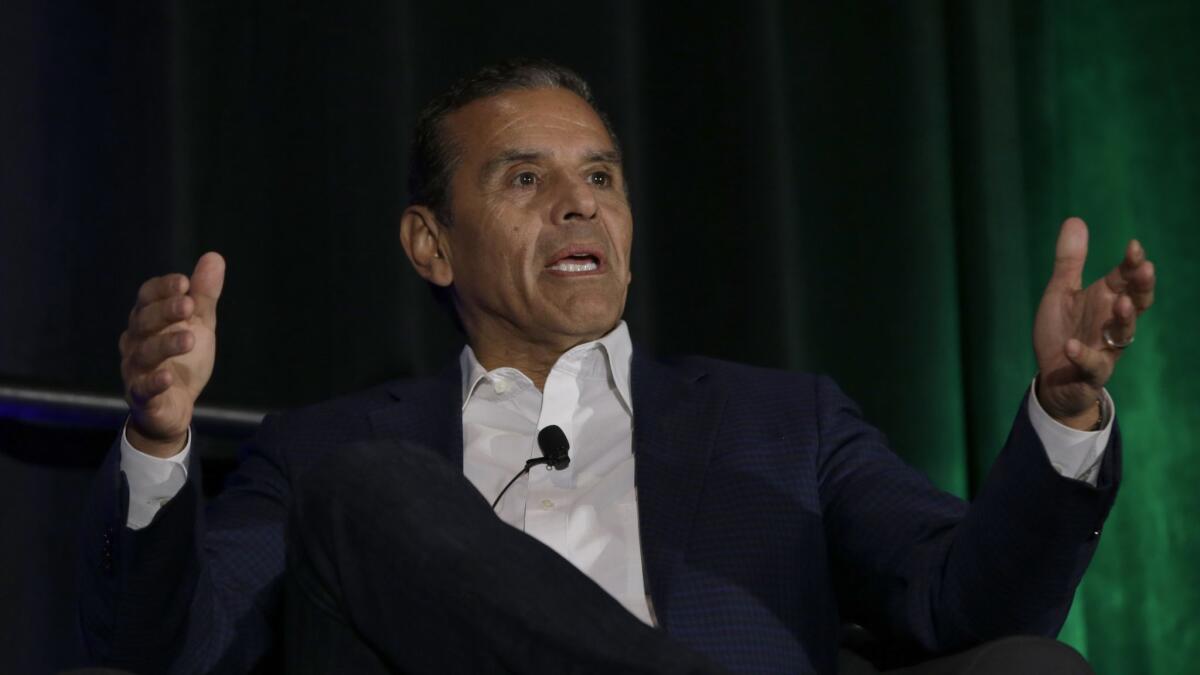
State Treasurer John Chiang, the other major Democrat in the running, has also urged caution. Instead of transforming healthcare in California in one fell swoop, the state should implement single payer bit-by-bit to ensure that it’s affordable and effective, he said.
“I support single payer, but we have to be truthful here,” Chaing said during a fall Democratic debate in San Francisco. “How many of you want to pay an additional 90% in taxes? … Let’s scale up, see what revenues we have, because we can’t cover everything.”
In Washington, former presidential candidate Sen. Bernie Sanders (I-Vt.) is leading a push for a plan that would in essence expand Medicare to provide healthcare to all Americans., For now, it’s little more than a political mirage — the Trump administration and congressional Republicans have been trying to repeal, not expand, government healthcare coverage provided under the Affordable Care Act.
With federal action unlikely, the California Legislature debated in 2017 whether to implement a state-sponsored single-payer system. The legislation, Senate Bill 562, was shelved in the Assembly over concerns about the cost and the lack of a comprehensive plan of how to pay for and implement such a massive new government program. A legislative analysis estimated the cost to be $400 billion per year. Half of the money for the system would come from existing state funds currently spent on healthcare, with the other half from new revenues such as a payroll tax, according to the analysis.
Newsom’s support of SB 562 has been nuanced. When he spoke at a convention of the California Nurses Assn., which endorsed Newsom and is the most vocal backer of the bill, he told the enthusiastic crowd, “It’s time to move 562.” But later, when talking with reporters, Newsom said he was referring to moving the bill through the legislative process, and acknowledged some “open-ended” issues still needed work.
When a coalition of labor unions, community health organizations and immigrant-rights groups tried to steer the healthcare debate away from SB 562 in March, proposing a series of measures to make healthcare in California more affordable and accessible, Newsom praised it as a “step in the right direction.” He said it had the potential to move California closer to universal coverage.
Villaraigosa and Chiang have accused Newsom of shifting his message on SB 562 to appease different audiences.
But Newsom has taken shots at them for playing both sides as well. Villaraigosa and Chiang say they support the concept of single payer — ideally at the national level — yet call Newsom fiscally reckless for supporting a California program. Newsom has insinuated that they lack political courage to make it happen.
He also said the hand-wringing over the cost of single payer is a “specious argument.” Most of the money needed to support a single-payer system already is being spent on the plans that it would replace, he said: government-run exchanges and private healthcare plans.
“I think we can achieve it. Let me tell you why: We’re already spending $367 billion a year on health insurance in the state of California,” Newsom said at a San Diego debate in February. “In every developed nation in the world that has a single-payer financing system, one thing is absolutely true: It costs less money than multi-payer.”
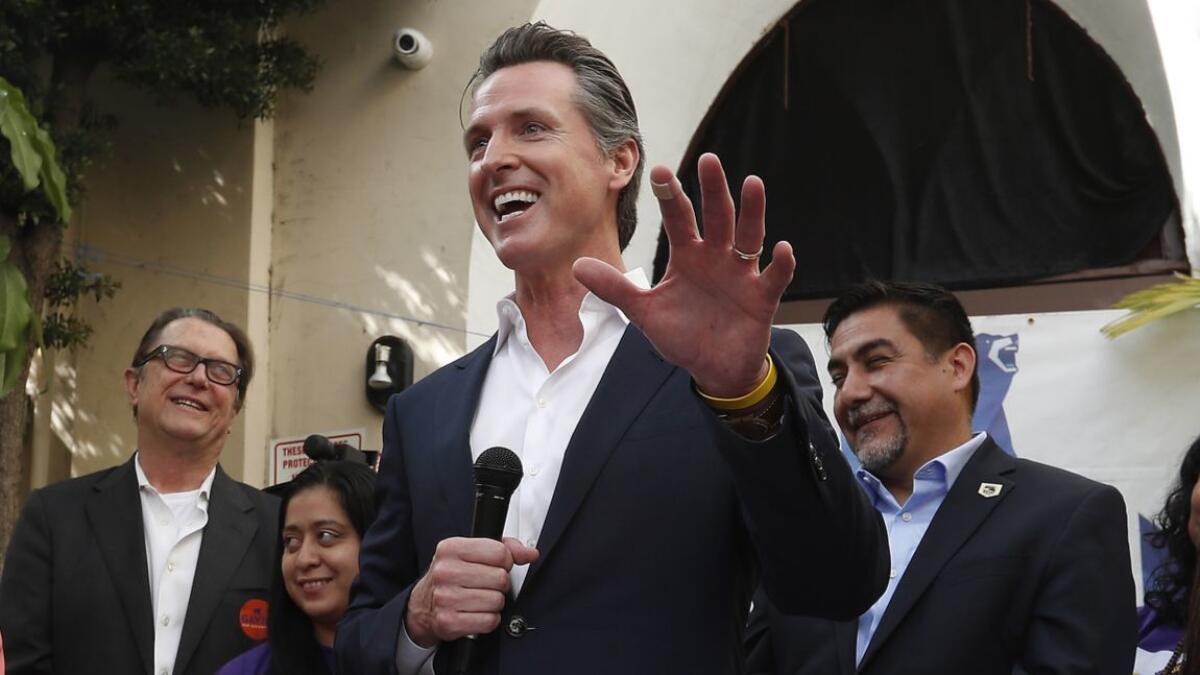
The $367-billion figure Newsom used comes from a 2016 study done in part by Gerald Kominski, a professor of health policy at UCLA. Kominski agrees that, in theory, additional revenue might not be necessary if all of that money spent on healthcare in California can be funneled to a single state healthcare agency. Still, that would require permission from the Trump administration and Republican-led Congress — both hostile to Democratic leaders in California — to take control of Medicare and Medi-Cal funding Washington sends to the state, as well as convincing all Californians to switch to state-run healthcare coverage.
“There are still some significant barriers,” Kominski said.
Micah Weinberg, president of the Bay Area Council Economic Institute, said Newsom fails to account for the increased costs of the comprehensive coverage being promised under a state single-payer system. Those costs include covering an estimated 1.8 million immigrant adults in California who are in the U.S. without authorization and covering long-term care not covered by Medicare, as well as eliminating all deductibles and other out-of-pocket expenses for Californians, he said.
“We’re being misled into believing that if you provide free universal care, it’s going to cost less,” Weinberg said.
Eastin, the only candidate of the four to throw her unequivocal support behind SB 562, has said implementing single payer is essential because “people are dying” for lack of proper healthcare. She has also acknowledged that it won’t be simple.
“What we have to do is have a conversation, an adult conversation, with real leaders at the table talking about how were going to close the gap and get additional money,” Eastin said at one of the Democratic debates, adding that she’s open to exploring different revenue sources, including a gross receipts tax.
The two top Republicans in the race, Rancho Santa Fe businessman John Cox and Huntington Beach Assemblyman Travis Allen, have both ripped single payer as a government boondoggle.
Cox mockingly suggested that the state could also provide “single-payer food and single-payer housing” for everyone. Allen said it would be as efficient and customer-friendly as the DMV and bankrupt the state.
A 2017 poll by the nonpartisan Public Policy Institute of California found that 65% of adults in California favored the creation of a state single-payer healthcare program, but that support dropped to 42% when asked about paying higher taxes to fund it.
“You have to wonder, over time, whether this an issue that candidates want to own,” PPIC President Mark Baldassare said.
Twitter: @philwillon
Updates on California politics
More to Read
Get the L.A. Times Politics newsletter
Deeply reported insights into legislation, politics and policy from Sacramento, Washington and beyond. In your inbox three times per week.
You may occasionally receive promotional content from the Los Angeles Times.

